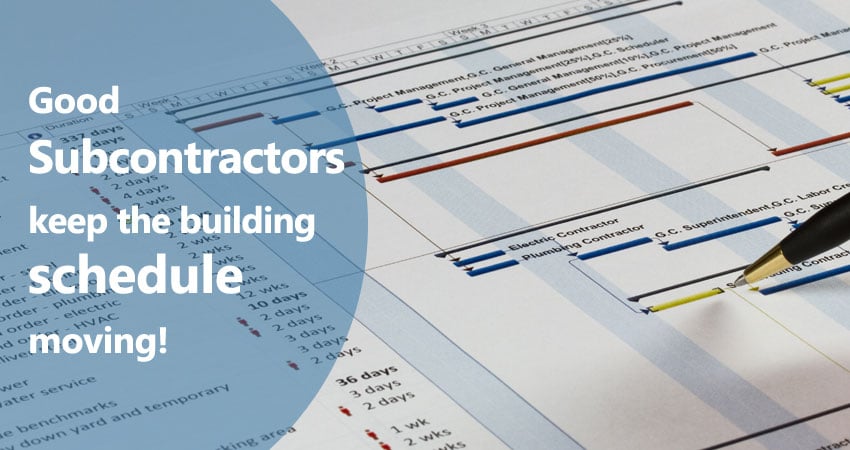
Every Builder knows that having a solid specialty subcontractor base can make or break the company. Subcontractors who show-up on time and complete their jobs 100% keep the building schedule moving. Contractors who don’t, create complications and delays that can give the Builder a bad reputation.
That’s why it’s critical to have a standardized system to track and evaluate subcontractor performance.
Your quality control system can be used to evaluate, score and then reevaluate the subcontractors working on the jobsite. It can spotlight top performers as well as weak links.
That info is vital to run a smooth construction schedule and operate a profitable construction company. And, basically, builders can use the QC system to do this in four steps.
Establish Key Performance Indicators for each activity
The construction schedule is made of seventy plus individual activities that must each be completed in rapid succession, much like a line of dominoes. If one fails to fall, fall in time or fall in rhythm, the entire line ahead stops. To keep the rhythm, so to speak, the Builder must determine the Key Performance Indicators for each activity.
These performance indicators are the factors that determine an activity to be 100% complete and ready for the next activity to begin.
For example, the frame boards must be accurately measured (a key Performance Indicator) before the slab can be poured. The builder's QC System should have specific performance criteria for each activity that must be met before it’s considered complete. That criteria is used to evaluate trade and subcontractor performance.
Evaluate the Subcontractor’s work against Key Performance Indicators
Once you've developed your performance criteria, you will want to evaluate your subcontractors' against it. Good Quality Management Software has several tools for evaluating a subcontractor performance including inspection forms, checklists, a scoring & ranking process, and reporting tools.
The software can use your activity’s Key Performance Indicators to measure how well a subcontractor is performing. In addition to activity specific points, these metrics can also score general expectations, such as arrival time, phase completion, callbacks, punch list items and jobsite cleanliness, to name a few.
You can also track the number of corrective actions issued and the amount of material returned because the supplier failed to meet standard specifications. (Looking at you, Lumber Company!) It can also track warranty issues back to a specific Trade. These Key Performance Indicators measure subcontractor performance from Purchase Order through the Owner warranty phase and beyond.
Read How to use QC to improve your Subcontractors Performance
Determine who reviews the Subcontractor evaluations
The next step is to determine who reviews that data. Honestly, that “who” shouldn’t be one person alone; subcontractor performance doesn’t just affect the jobsite Construction Manager.
Good or bad, their work ultimately impacts purchasing, scheduling, warranty, customer service, management and even sales. Purchasing can utilize warranty data, product scores and material availability to make better buying decisions.
Scheduling can determine which crews are showing up on time, completing the job per the schedule and have the fewest callbacks.
Clearly, you will want to utilize those crews over the under performers. Management can see bottlenecks and delays, and can use QC data to help prevent them from occurring in the future.
Even Sales has some skin in the game. When the Sales Team recognizes a subcontractor’s positive evaluation, it gives them another point to talk about with potential customers and another advantage over the competition.
Acknowledge good performance and act on red flags
When monitoring a subcontractor's performance, you must show appreciation for a job well done, as well as act on red flags. Give a contractor additional contracts for excellent work, or a bump in pay.
That will strengthen the productive, profitable job performance. On the flip side, pay close attention to red flags. Counsel a subcontractor with performance issues and get to the root of the problem.
Share Hot Spot photos and QC performance reports. That may require additional time and energy, but strategically it’s always better to avoid turn-over whenever possible.
The QC process isn’t just about scoring the subcontractors and dropping the hammer, but helping them grow their business as your business grows. Of course, no Builder should tolerate ongoing bad service. And if the you must cut ties with a subcontractor, the QC data and reports provide accurate back-up.
Conclusion
Successful Builders consider their Subcontractors as part of the team and treat them as such. The Builder-Subcontractor relationship is a business partnership, with both companies working toward the same goal.
Using a standardized system to track and evaluate subcontractor performance will help both you and your subcontractors become more successful. In the long run, having an efficient, reliable subcontractor base will be your competitive advantage.
If you are looking for Subcontractor Performance Review Templates, then you should check out our Subcontractor QC Package at our sister site First Time Quality.

